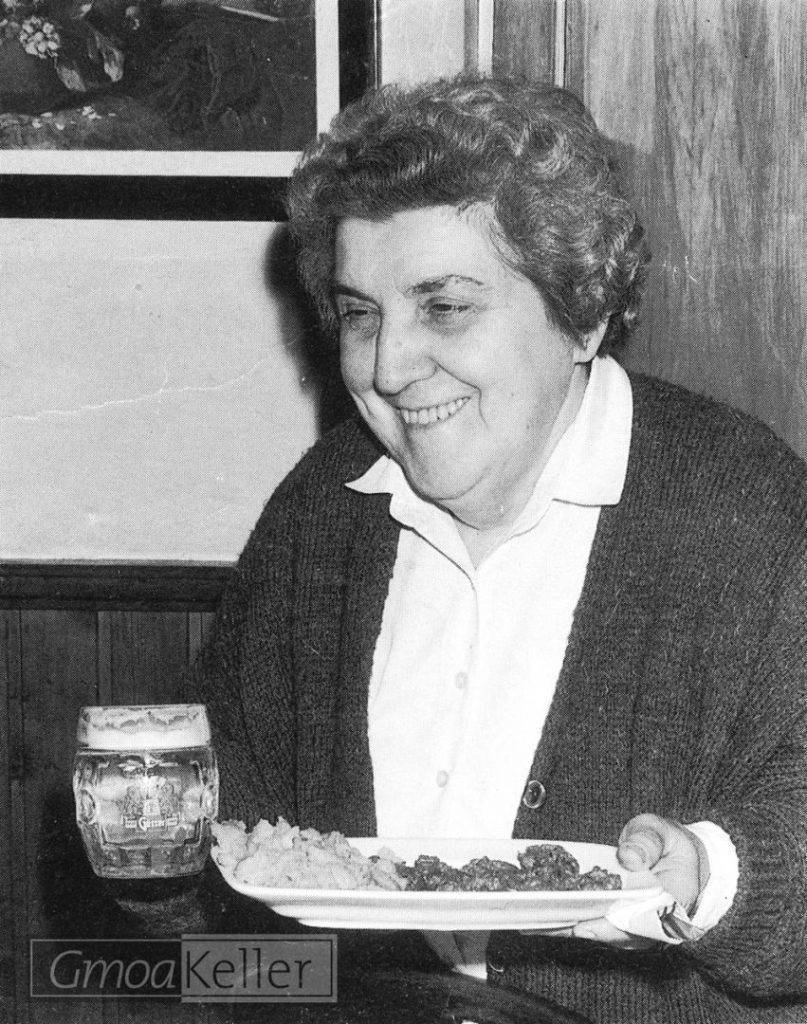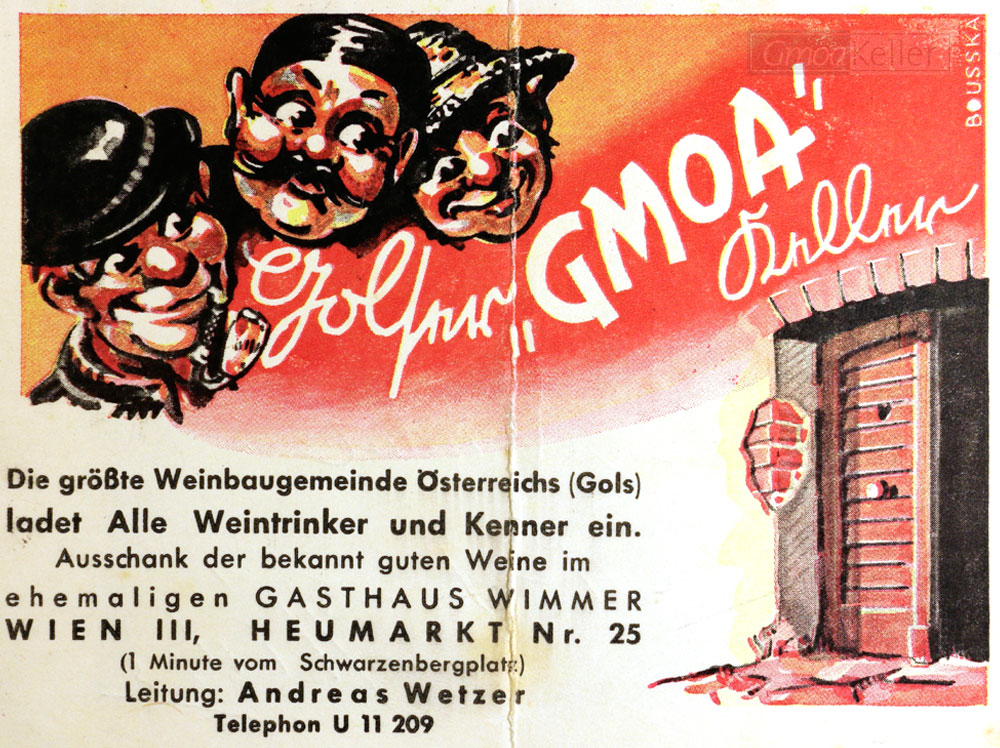Tribute to Anton Ölzelt
History of a landmark
Crown Prince Rudolf and Mary Vetsera are said to have met secretly in today's Gmoakeller, which is why the restaurant was called "Zum Kronprinzen" for a long time. The house and restaurant were built in 1858 by master builder Anton Ölzelt the Elder.
Around the middle of the 18th century, the area south of today's Marokkanergasse became the k.k. Reiterkaserne, later called Fuhrwesen and finally Heumarkt-Kaserne from the 1840s. The extensive barracks building was demolished at the beginning of the 20th century, the grounds were parceled out and partially built on.
To the east of Heumarkt, the city architect Anton Oelzelt (1817-1875) acquired several plots of land, which he developed with residential buildings in the 1850s. All of them display the typical small-scale decor of Romantic Historicism, sometimes combined with elements of the English Tudor style. Before 1846, Oelzelt worked in Znojmo, among other places, and from 1850 he was k.k. Court architect. From 1856 to 1860 he worked as a master builder for Ferstel's Austro-Hungarian Bank on the Freyung.
The house at Heumarkt 25, on the corner of Marokkanergasse 1 and Oelzeltgasse 12, was also the work of master builder Anton Oelzelt. There had been an inn there since it was built in 1858. The street level was at the same level as today's side road, so it is likely that an outdoor dining area was already in operation in the past.

A typical Viennese pub had a black oiled floor, green-painted windows and - at least partially - wood-paneled walls on which the gardaro hooks were attached. The centerpiece of the restaurant was the bar with a tin cover and built-in glass sink, behind which was the refrigeration system with taps for beer and soda water. Until the post-war period, cooling was still carried out using blocks of ice delivered by large ice carts. Pass-throughs to the kitchen were popular, where the regulars' table for particularly dear guests or family members could be found. The area around the regulars' tables was decorated with vacation greetings or original photos of regular guests hanging on the walls.

Around 1940, Andreas Herzog acquired the Wimmer inn "Zum Kronprinzen" and began wholesaling wines from Gols. Herzog came directly from Sopron and not only ran the inn, but also a wine trade with Gols wine. Somehow, the Gmoa-Keller in Gols actually took on the function of a "village inn" for the surrounding area: it was the exchange for locally important news, and many families left their keys to their apartments here. The "Grätzl celebrities" also had their regulars' tables in the Gmoa-Keller.
Up to seven waiters used to run the Gmoakeller. Later, the owner Grete Novak managed it alone with the help of one - mostly Hungarian - relative (Rozsi, Marika or Vera) and with the help of regular guests, because everyone was responsible for "their" table and therefore had to serve "their" people themselves.
Musicians, actors, ambassadors, cabaret artists and even clerical dignitaries would stand in the queue in front of the bar or kitchen, waiting for their beer, wine, an "Obi-G'spritzt", gulyas or beuschl. If there was a need, particularly trusted regulars were even allowed to wash a few glasses.
After the war, many political celebrities came to the restaurant, as a number of party conferences were held in the Konzerthaus - many of the other function rooms had been destroyed; visits by Figl, Pittermann, Schärf, Körner and Raab have been recorded. The party often went on late into the night, so that the staff spent the night on the large pub tables in order to be able to open up again in time in the morning.In the course of the Hungarian Revolution in 1956, many members of the Herzog family came to Vienna from Sopron. At first, they were happy to find shelter with Andreas' uncle. Up to fifteen family members slept in two rooms and three cabinets in the apartment belonging to the inn. For the seven children, the parlor became a living room and an adventure playground.
In 1956, the Herzog family (the maiden names of the four sisters Grete, Mitzi, Hedi and Gizi) came from Sopron to join relatives already living in Vienna. Hungarian was therefore the colloquial language in the kitchen; in the dining room, however, Mitzi and Grete spoke Viennese, as was customary among the local population in old Ödenburg.
After the death of her uncle around 1960, Grete took over the inn. It flourished until the 1970s. Jazz was played in the cellar in the post-war years, the "Vienna Hot Club" had its domicile there, Joe Zawinul and Fatty George played here. The bowling alley(!) was eagerly used by the construction workers of the Hotel Intercontinental.
At the age of almost 40, she married Novak, the Vienna Philharmonic's French horn player, who was 20 years her senior. After a short, very happy marriage, the pub finally became the center of her life. She regularly visited her husband's grave on Sundays until the end, as long as her health permitted.
In the time of the "Beislsterben", business was also bad in the Gmoa-Keller. Around 1970, the restaurant was rediscovered by a number of young actors; music students, choir singers and journalists contributed to a rejuvenation of the audience, as did foreign flight crews who spent the night in the Hotel Intercont and appreciated typical Viennese pubs; world-famous philharmonic orchestras came after concerts, and more and more celebrities celebrated their birthdays or presented books here.
In autumn 1998, Grete Novak was awarded the Golden Medal of Honor of the Republic of Austria for her "commendable services to the local pub culture". She was an honorary citizen of Vienna-Landstraße and recipient of the Golden Medal of Merit of the town of Gols.
After Grete Novak's death on February 9, 1999, her sister Hedvig Vécsei (née Herzog) took over the restaurant at the age of 81 (where she had already worked with Grete and Mitzi for twenty years) in order to ensure that the GmoaKeller would continue in Grete's spirit - i.e. as unchanged as possible. Hedvig Vécsei died on May 18, 2010 in Vienna.
Within a generation, very little of this has remained. The new pubs have become brighter and easier to clean, curtains and tablecloths are coordinated, and of course there is central heating and hygienic toilets. Old household items are often hung on the walls for decorative purposes and the furnishings are mostly rustic, all new of course, as patina is frowned upon.
The menus are international and have replaced roasted potatoes, breaded Leberkäs or sausages with juice. New eating habits are replacing the old, a process that progresses almost imperceptibly over many years. Suddenly an old-style pub has become a rarity, it can even turn into a celebrity hangout, precisely because time seems to have stood still in terms of both the furnishings and the menu.
A particularly fine example of such a Viennese inn is the (Gols) Gmoa-Keller.
The entrance door was usually glazed, often connected to another door - sometimes with a thick curtain - as a vestibule. Each of these doors made an unmistakable sound, so that unconsciously an acoustic signal was also part of the entrance to the respective Stammbeisl.the smell of roasted onions or gulyas was also typical of a Viennese inn, as was the lazy atmosphere on hot summer days when only a few guests were present, and when there was often time for very personal conversations. Pass-throughs to the kitchen were popular, near which the regulars' table for particularly dear guests or family members could be found. The area around the regulars' tables was decorated in a special way with vacation greetings or original photos of regular guests hanging on the walls.